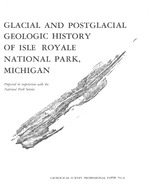Isle Royale was overridden by glacial ice during each of the four major glaciations of the Pleistocene Epoch, and each successive glaciation essentially obliterated all direct evidence of preceding glaciations on the island. In the waning phase of the last major glaciation, the Wisconsin Glaciation, the frontal ice margin retreated northward from at least the greater part of the Lake Superior basin, then readvanced into the basin during Valders time, about 11,000 years ago. We can attribute to the Valders ice the final aspect of glaciation on Isle Royale, including both erosional and depositional features.
It is impossible to estimate the quantity of glacial debris or other surficial materials that might have been present on Isle Royale prior to the Valders readvance, but the readvancing ice appears to have removed most of what might have been present, as judged by the thin surficial cover on the eastern two-thirds of the island today. During the Valders retreat, a series of lakes formed in the Lake Superior basin in front of the retreating ice margin.
The retreating ice opened successively lower outlets, and thus the general trend of lake elevations is downward. Distinct lake stages reflect periods of relative stability during which well- defined shoreline features developed. The ice front forming the north margin of the earlier lakes probably remained south of Isle Royale until about the time of glacial Lake Beaver Bay, when it retreated to a position straddling Isle Royale west of Lake Desor. Abundant deposits of glacial debris were left upon the newly deglaciated west end of the island, and the ice front remained stable long enough to build a complex of ice-margin deposits across the island. Shorelines formed by the glacial lake associated with this ice front are found on the western part of the island about 200 feet above present Lake Superior.
Subsequent renewed and complete retreat of the ice margin from Isle Royale was rapid enough that only a minor amount of glacial debris was deposited on the central and eastern parts of the island. When the ice margin reached the north edge of the Lake Superior basin, Lake Minong was formed, and the entire basin was filled for the first time since the Valders advance. Lake Minong marked a relatively stable episode in the history of the basin, and its beaches are among the best developed of the abandoned shoreline features on Isle Royale. Lake Minong beaches and later lower beaches are best developed on the southwest end of Isle Royale, where abundant glacial debris provided easily worked materials for beach construction.


